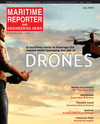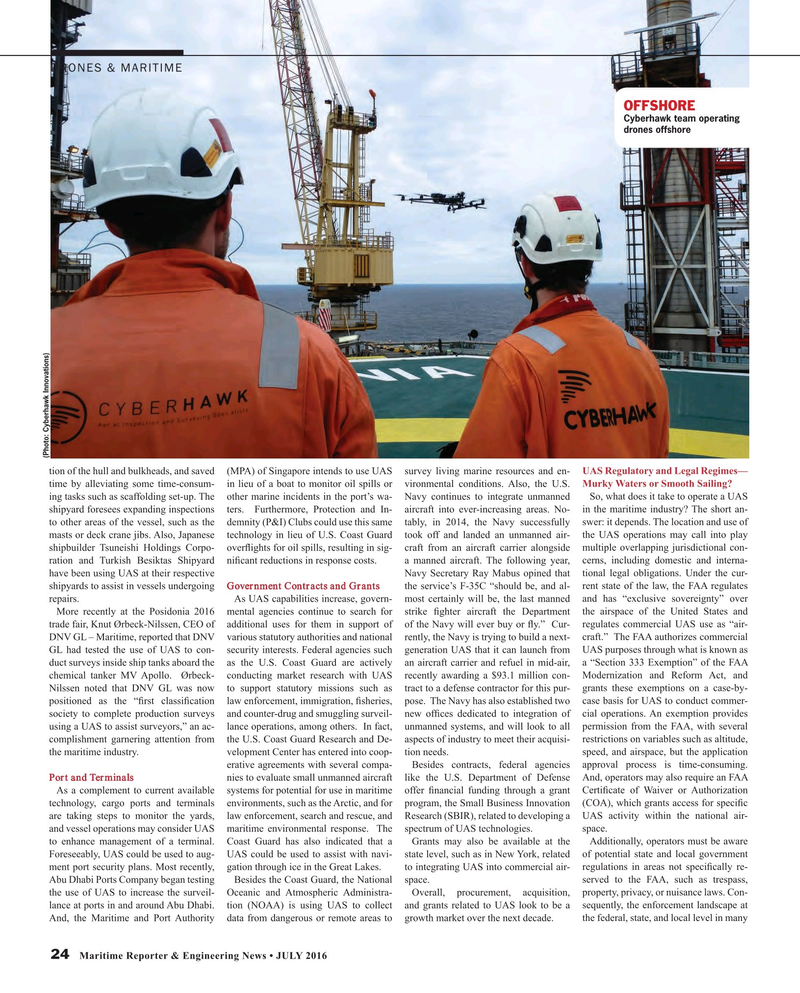
Page 24: of Maritime Reporter Magazine (July 2016)
Marine Communications Edition
Read this page in Pdf, Flash or Html5 edition of July 2016 Maritime Reporter Magazine
DRONES & MARITIME
OFFSHORE
Cyberhawk team operating drones offshore (Photo: Cyberhawk Innovations) tion of the hull and bulkheads, and saved (MPA) of Singapore intends to use UAS survey living marine resources and en- UAS Regulatory and Legal Regimes— time by alleviating some time-consum- in lieu of a boat to monitor oil spills or vironmental conditions. Also, the U.S. Murky Waters or Smooth Sailing?
ing tasks such as scaffolding set-up. The other marine incidents in the port’s wa- Navy continues to integrate unmanned So, what does it take to operate a UAS shipyard foresees expanding inspections ters. Furthermore, Protection and In- aircraft into ever-increasing areas. No- in the maritime industry? The short an- to other areas of the vessel, such as the demnity (P&I) Clubs could use this same tably, in 2014, the Navy successfully swer: it depends. The location and use of masts or deck crane jibs. Also, Japanese technology in lieu of U.S. Coast Guard took off and landed an unmanned air- the UAS operations may call into play shipbuilder Tsuneishi Holdings Corpo- over? ights for oil spills, resulting in sig- craft from an aircraft carrier alongside multiple overlapping jurisdictional con- ration and Turkish Besiktas Shipyard ni? cant reductions in response costs. a manned aircraft. The following year, cerns, including domestic and interna- have been using UAS at their respective Navy Secretary Ray Mabus opined that tional legal obligations. Under the cur- shipyards to assist in vessels undergoing Government Contracts and Grants the service’s F-35C “should be, and al- rent state of the law, the FAA regulates repairs. As UAS capabilities increase, govern- most certainly will be, the last manned and has “exclusive sovereignty” over
More recently at the Posidonia 2016 mental agencies continue to search for strike ? ghter aircraft the Department the airspace of the United States and trade fair, Knut Ørbeck-Nilssen, CEO of additional uses for them in support of of the Navy will ever buy or ? y.” Cur- regulates commercial UAS use as “air-
DNV GL – Maritime, reported that DNV various statutory authorities and national rently, the Navy is trying to build a next- craft.” The FAA authorizes commercial
GL had tested the use of UAS to con- security interests. Federal agencies such generation UAS that it can launch from UAS purposes through what is known as duct surveys inside ship tanks aboard the as the U.S. Coast Guard are actively an aircraft carrier and refuel in mid-air, a “Section 333 Exemption” of the FAA chemical tanker MV Apollo. Ørbeck- conducting market research with UAS recently awarding a $93.1 million con- Modernization and Reform Act, and
Nilssen noted that DNV GL was now to support statutory missions such as tract to a defense contractor for this pur- grants these exemptions on a case-by- positioned as the “? rst classi? cation law enforcement, immigration, ? sheries, pose. The Navy has also established two case basis for UAS to conduct commer- society to complete production surveys and counter-drug and smuggling surveil- new of? ces dedicated to integration of cial operations. An exemption provides using a UAS to assist surveyors,” an ac- lance operations, among others. In fact, unmanned systems, and will look to all permission from the FAA, with several complishment garnering attention from the U.S. Coast Guard Research and De- aspects of industry to meet their acquisi- restrictions on variables such as altitude, the maritime industry. velopment Center has entered into coop- tion needs. speed, and airspace, but the application erative agreements with several compa- Besides contracts, federal agencies approval process is time-consuming.
Port and Terminals nies to evaluate small unmanned aircraft like the U.S. Department of Defense And, operators may also require an FAA
As a complement to current available systems for potential for use in maritime offer ? nancial funding through a grant Certi? cate of Waiver or Authorization technology, cargo ports and terminals environments, such as the Arctic, and for program, the Small Business Innovation (COA), which grants access for speci? c are taking steps to monitor the yards, law enforcement, search and rescue, and Research (SBIR), related to developing a UAS activity within the national air- and vessel operations may consider UAS maritime environmental response. The spectrum of UAS technologies. space. to enhance management of a terminal. Coast Guard has also indicated that a Grants may also be available at the Additionally, operators must be aware
Foreseeably, UAS could be used to aug- UAS could be used to assist with navi- state level, such as in New York, related of potential state and local government ment port security plans. Most recently, gation through ice in the Great Lakes. to integrating UAS into commercial air- regulations in areas not speci? cally re-
Abu Dhabi Ports Company began testing Besides the Coast Guard, the National space. served to the FAA, such as trespass, the use of UAS to increase the surveil- Oceanic and Atmospheric Administra- Overall, procurement, acquisition, property, privacy, or nuisance laws. Con- lance at ports in and around Abu Dhabi. tion (NOAA) is using UAS to collect and grants related to UAS look to be a sequently, the enforcement landscape at
And, the Maritime and Port Authority data from dangerous or remote areas to growth market over the next decade. the federal, state, and local level in many 24 Maritime Reporter & Engineering News • JULY 2016
MR #7 (18-25).indd 24 7/6/2016 10:44:39 AM

 23
23

 25
25
